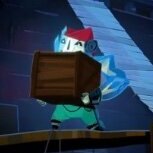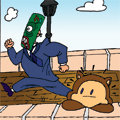Leaderboard
Popular Content
Showing content with the highest reputation on 04/27/22 in all areas
-
My old account seems to be hard to reach, so... Just to add some nerdy details to elTee's explanation, and some things I noticed when I looked at it again. SCUMM has a wait-for-message command (Ron explains it a bit in the Video Game History Foundation video). It causes the script to wait until dialogue is done displaying before continuing. There are two things Elaine can say at that point (won't spoil the other one, just in case), and in the case of the "spell" line, there's no wait-for-message immediately after her dialogue. That's intentional: In PC VGA mode, the line is followed by a fade-out to black (fade all colors to black) over 25 frames, and then we have the wait-for-message call. Meaning it will fade out while she's talking. In EGA mode, the screen immediately cuts to black, with the wait-for-message coming before that cut (otherwise, we might not see the text at all). And then there's the Amiga graphics mode. Which does exactly the same as the EGA mode - it cuts straight to black - but with wait-for-message after the cut. Meaning the script will tell the engine to display the line, and immediately change all colors to black - in the same frame. Which doesn't give Elaine much time to finish talking (none at all). The thing I realized when looking again is that - like most fades in SCUMM - the low 16 colors in the palette aren't faded. Those are colors used for (among other things) dialogue lines (they're mostly the typical EGA palette). Meaning Elaine's dialogue line will stay on screen all the way through the fade. The Amiga version actually does the same - it cuts all 256 colors to black except the low 16 colors - but the Amiga version doesn't use those colors for the text (or anything at all, actually). So that won't help either. It then looks like they tried to fix it by changing two colors back to full color intensity - probably the colors used for the text (but haven't looked further to be sure about that - may also be two colors used later). If it's intended for letting her text show, the problem with that is that that color change command comes after wait-for-message. So Elaine will be done talking before the two colors come back. So: 1. Elaine says the line 2. Colors 16-255 are changed to black 3. Wait for Elaine to be done talking 4. Colors 46-47 are changed to full color again ETA: Looked at colors 46-47 in the palette, and sure enough, they're dark gray and magenta = the color of Elaine's dialogue. So seems point 4 likely really was an attempt at a fix.5 points
-
elTee just said it, about the other dialogue. 🙂 It's definitely a bug - even though the Amiga only had the 32 colors (using the colors 16-48 in a 256 palette, with the rest unused), the intention was clearly to either: Not cut to black until Elaine was done talking (like the EGA version), or Cut to black, but keep Elaines talk colors so the sentence would be on black (like it is in the PC VGA version). Both could be done, either by: Putting wait-for-message before the cut, or Changing all colors (16-255) to black, then changing color 46-47 (the talk colors) to their actual colors - then wait-for-message. In pseudo-SCUMM without the choices between display mode, and with a totally made-up color-lightness command (which isn't what it would actually be called or look like, but something like it): say-line elaine "I hope LeChuck hasn't cast some horrible SPELL over him or anything." wait-for-message color-lightness of 16 to 255 is 0 ; only change colors to black when Elaine is done talking or say-line elaine "I hope LeChuck hasn't cast some horrible SPELL over him or anything." ... color-lightness of 16 to 255 is 0 color-lightness of 46 to 47 is 255 ; undo the blackness of those two colors wait-for-message ; NOW we wait for Elaine to stop talking - her dialogue will be visible on black background Instead, the wait is after the cut, and the talk colors are "fixed" after the wait. 🙂 The actual Amiga code: say-line elaine "I hope LeChuck hasn't cast some horrible SPELL over him or anything." ... color-lightness of 16 to 255 is 0 wait-for-message ; all colors are now black, and we wait for Elaine to stop talking ; another command here to deallocate the Elaine actor color-lightness of 46 to 47 is 255 ; now we change the colors of a dialogue line that's no longer displaying, hrm... See, it's close (although trying to do both things at once) - just the order that's wrong. Probably someone not quite remembering exactly what wait-for-message actually does, or when screen updates are done.3 points
-
Okay, I hate to say it but this looks like a bug. I went right to the top with this and asked one of the cleverest people I know, Jimmi (serge) of Scumm Rev fame, if he could help me figure it out and he was kind enough to take a look. We checked the script using descumm and sure enough, Elaine's line about the SPELL is there and it's supposed to be displayed. The best working guess we have right now is that there's a call to the Amiga graphics settings to make the screen fade to black, and unfortunately it does this BEFORE it displays the line of dialogue. Which of course, to the player, is the same as turning the dialogue off because the screen has already faded to black. This may not be the exact reason for the bug, and I may have misinterpreted the explanation a bit, but the dialogue is definitely in the code for the Amiga version so I'm confident chalking this up as an error.3 points
-
Thank you very much. I'm a longtime visitor, but actually a first-time poster. 🙂 Not that I'm an expert on this (far from it), but it is my understanding that LucasArts games as a whole were perceived this way back in the day, even within the industry. Not too long ago, I read a recent interview with a Sierra alumni (I think it was Josh Mandel), and he mentioned that Sierra staff used to be a bit jealous of LucasArts because of their no-expenses-spared, blockbuster-like approach. I also seem to remember reading (citation needed, though) that one of the reasons which led Blizzard to cancel the Warcraft adventure game was that, after seeing how technically impressive The Curse of Monkey Island was, they felt their own game felt too cheap by comparison. It's kind of crazy to think about it nowadays, but there was a very brief period in videogame history in which adventure games as a whole could not only go toe-to-toe with the "big guys", but were actually early adopters of many technologies. I mean, some of these adventure games had massive scripts which were fully voiced by professional voice actors (with very decent sound quality), in a time when other major franchises, belonging to other major genres, still only included some sporadic, barely-comprehensible synthesized voice samples. And didn't Creative bundle the CD version of The Secret of Monkey Island to promote one of their Sound Blaster cards? Anyway, more on topic: since we are discussing the prospect of a potential Loom remaster/sequel, I think this extract from a 2017 interview with Brian Moriarty might be of interest (it kind of relates to what I mentioned in my previous post, too):2 points
-
Oh yeah, I'd love it if the game returned to the somewhat more cruel sense of humor of the first two games. Even in EFMI some of the best jokes came from Guybrush cluelessly doing some really bad things in SoMI (like how he just left his crew stranded on the island and how the monkey that opened the gate to the monkey head eventually died from exhaustion).2 points
-
Right 🙂 - but there are always these kinds of strange choices and mistakes in any programming - not least in SCUMM (Maniac Mansion, for example, has several different ways of waiting for actors to finish their dialogue, probably because things were implemented as they went along). There might have been a performance issue with fading just at that point, for whatever reason, and it might even have been fixed, but no-one remembered to change the code.2 points
-
Interesting! Thanks for discovering that. I had a feeling it would be a bug as I remember the Amiga barely showing certainly lines before fading to black (eg. "Death was so close I could smell his hairy armpits").2 points
-
There's a new niggles in the Double Fine remasters that irk me to this day, but on the whole they're amazing. The Grim Fandango Remaster in particular is worth it for the new controls alone -- but add the massively improved music and WOW, it's more or less perfect. Schafer promised a "Criterion Edition" level remaster. He talked about getting the symbol on Velasco's cap correct, for example... That's extremely detailed. Except they didn't touch the texture on Velasco's cap. In fact they didn't touch quite a few textures. And sometimes when they did change them, they added silly mistakes. They removed the originally intended numpad tank controls for some reason. And they also changed the beautiful transition before the end credits. Plus there's a few bugs (I have a list somewhere.) They also massively lowered the available number of save slots (due to a PS4 limitation, but contractually it had to be implemented on the PC version, too -- because the PC version couldn't be better than the PS version), which is unbearable for a huge game like Grim that you might want to explore. Still, overall it was VAST improvement, and definitely the version everyone should play... just not quite Criterion Edition level. Full Throttle also had some oddities introduced (some character designs were changed, some background animations were lost, and there were some strange choices during the animations). Plus the background on the road animations were altered so they didn't match the rest of the game. And whoever was in charge of uprezzing the fonts did not have a very good eye. Still, again, the improved music was worth the price of admission. Watching the intro sequence on my big TV with the music blaring in HD gave me goosebumps. The Day of the Tentacle Remaster was probably the most faithful overall. Very nicely done, although I wish they didn't have music playing in the menus. It drove me insane after a while. Of course all of this is just because I'm an uber fan. 99% of people will just enjoy the DF Remasters, and so they should. They're fantastic. (But I still have dreams of modding them for to my own taste just to scratch that uber fan itch.)2 points
-
Hi everyone. Longtime visitor, checking in after all these years. In addition to all the issues you have already discussed, there is an extremely subtle, almost conceptual reason which makes these recent(ish) remasters feel somewhat "off" to me. It applies to the two Monkey Island Special Editions, but also to the more faithful Double Fine remasters (less so with Grim Fandango, but still). It's basically this: the original versions look and feel like state-of-the-art, early/mid 90's games (because that's exactly what they were). The remasters look and feel more like modest, 2009-2017 indie games (because that's kind of what they are). Back then, these games were bona fide technical juggernauts. They have a very specific place in videogame history, and you can feel that even when playing them today. With these new-coat-of-paint-on-top-of-the-old-game remasters, however, they stop being products of their time and become something else. Their place in history is palpably different to that of the originals, and I think that colors the experience of playing them. Substantially so.2 points
-
I only just became aware of this, but apparently the Amiga version didn't include the "I hope LeChuck hasn't put a SPELL on him or anything" line at the end. Those of us who played the Amiga version had even less of a clue what the ending meant... no wonder we were traumatised 😆 I know there's some other minor artwork differences, but it makes me wonder when that line was added... or if it's just a bug? (Also wasn't aware until now that Tami Borowick led the Amiga conversion... I wonder what her memories of that project was, given that it was the version we played for so many Europeans.) Video below will jump straight to the scene in question...1 point
-
How about a drinking contest ? Winner gets the doll! (Need to find near-grog quick)1 point
-
I don't know that it was a particularly troubled development, in comparison with any other game he's made. Certainly the original Psychonauts, and Brutal Legend had a rather troubled development, they had to make lots of cuts from Full Throttle, and so forth. The main difference between Broken Age and those other games is that it was developed under public scrutiny, so things that would have happened in the dark and maybe talked about years later instead happened in the open. Like, let's say there'd never been a Kickstarter, but instead Tim got funding from a publisher to make Broken Age and it was announced at some point during development. Well, at the point where they started to realise they didn't have enough money to realise the whole vision, probably one of 3 things would have happened: 1) They ask the publisher for more money, they get it, and nobody ever hears or cares about that they had some budget issues. 2) They decide to make significant cuts to the game, and maybe people think it's a bit short, but by the time they release the game, whether they had to cut bits out would have been a matter of speculation and nothing more until they talk about what they cut years later (like Full Throttle) 3) Something like what they actually did, they decide to split the game and release it part 1 first, standalone. They're free to act like this was always the plan because they never announced otherwise, and they use the profits from it in order to fund the 'sequel'. I wonder if in any of those scenarios we'd really be thinking of Broken Age as having a 'troubled development' or if we'd just be thinking of it as a game (or two games) like any other that had its development ups and downs and eventually got released in some form. It's a bit like the situation with Psychonauts 2... people overemphasised in press chatter about it how long it was in development, but that development time was artificially inflated by 3 factors: 1) Because of the Fig funding, it was announced WAY before a game of this type would usually be announced, which made the development time feel much longer. 2) The Microsoft buyout bought them time and funds that they took advantage of 3) COVID slowing development for the second half. I guess what I'm saying is that a lot of this stuff has always felt like a bit of a false narrative generated by DF's relative openness compared with other devs. It says more about the stuff we DON'T see about other games, than it does about Broken Age, P2, etc. But... to address your question, I don't know. My sense from following DF closely for a number of years is that Tim isn't overly interested in revisiting the past. He'll dip into it with the remasters, and with Broken Age as an adventure game, and with Psychonauts 2, but all those had as much to do with keeping the company afloat as they did with what Tim wanted to do. I'm not saying they were cynical projects, but at some point it must have occured to the folks at DF that there's decent money in being able to capitalise on Tim's most beloved works, so it's a bit of a no brainer. But when you hear Tim talk about what he wants to do next, it's always something he's never tried before, and I think that's what he'll be drawn to especially now he knows he's not going to have to go round the world knocking on doors for money.1 point
-
Yes it is. The later games do definitely have their moments as far as "cruel humour" goes! As a side-note, I'm just picturing the level of speculation, concern and panic that would ignite in these threads in the event that the voice actor of Jojo Jr. announced they were returning for ReMI...1 point
-
Jojo Jr. tells Guybrush that his father, Jojo Sr. , was swinging on the lever that controlled the Monkey Head switch after being trained to hang there (in MI1), but never recieved the command to let go, so he "starved to death, waiting for a simple command that never came!" Guybrush can also examine his grave later on but I don't remember if he had any particular quips about it there. As a side note, the monkey in MI1 that hangs on the switch is never named in-game, but in MI2, the piano playing monkey is actually named Jojo, and is unrelated to both Jojo Jr. and Sr. I guess all monkeys in this world are just naturally called Jojo!1 point
-
Hmm! I'd like to see character growth. Most of MI1's 'jerk guybrush' moments seem to come from him just being kind of oblivious to things outside of his immediate goals. In MI2, it's a bit different, it seems to come a bit more from an inflated sense of self-importance. I think after the experience of the tunnels and Big Whoop, however they actually get addressed, Guybrush's idea of where he fits in the world might have shifted again. Maybe we're going to see a more thoughtful, philosophical version of Guybrush, or something. Of course, we're talking shades here. It's still going to be the fairly inept but oddly determined character we know, trying his best to live up to the mighty pirate profession.1 point
-
I definitely think that Thimbleweed Park was a way for Ron to work out some of his residual concepts from Maniac Mansion and the first two Monkey Island games, but I wouldn't say that I consider it a sequel. It certainly achieved its stated goal of feeling like a lost early LucasArts adventure game, at least for me personally. I really want to replay it, actually...1 point
-
Given that this a Loom thread, I must say I agree with this. Loom particularly has always struck me as absolutely state of the art for when it came out, from the astonishing dithered EGA art to the extraordinary level of detail put into the package. It does not look cheap or thrown together, it feels like the product of an enormously wealthy company throwing all of their resources at a project. None of the later games quite had that same feeling to me.1 point
-
Welcome back to the forums! I think you’re right about that. I don’t really like the uprezzed graphics either, although the work Double Fine did on them is top notch. I just love playing them with the old graphics but new sound. It’s such a thrill to hear these classic’s that I’ve always loved with the improved audio quality. It must’ve been a tough job finding all the right samples on tape, but it payed off perfectly! (Except for the suction cup effect which I mentioned earlier.)1 point
-
Fascinating! That would make sense, though it's certainly strange. Thanks for looking into it!1 point
-
Very interesting! I'd like to see the script for this version and figure out what the reason is... I wonder if descumm can help. I'll have a look in the morning, but I won't get my hopes up 😂1 point
-
Scratch that, I checked my Amiga version of MI2 in an emulator and you're absolutely right! Elaine doesn't mention the "voodoo SPELL" line, and the scene just cuts immediately to black. It matches the video pretty well. Interesting! Since the Amiga version also has the fish in the woodcutter's shop that was removed before the PC version shipped, I wonder if Elaine's line being added was a late change to the PC version... perhaps intended to shed light on what the intended interpretation of the ending was?1 point
-
That "oil can" is actually an expandable/accordion gas carrier so it is not meant to look like a metal oil can. But I can see what you're talking about with the resolution of characters and objects to the background. What I find more inexcusable is that green hose on the green background item right behind Ben there in that scene. I think it was an oversight during the conversion to the newer background. But I absolutely love Full Throttle (original and SE).1 point
-
1 point
-
Yeah, that's fair enough - I actually haven't played either of those on PC myself which is why I generalised in my post, but I understand Double Fine did a really comprehensive technical upgrade on their Special Editions so I shouldn't have lumped them in with the two that LucasArts did. There's also frankly an air of legitimacy with those re-releases that simply comes from Tim Schafer himself.1 point
-
I disagree about the Grim Fandango and Full Throttle remasters. While I haven't played them on pc, so I'm not sure how they work with mouse controls, the audio quality alone for me is a reason to prefer them above the originals. To hear Ben's gravelly voice without the hiss in the background is just music to my ears, not to mention the music literally being music to my ears! I'm not to keen on the Full Throttle visuals, but I can play it with the original graphics no problem. Day of the Tentacle was a close one, but the replacement of the tentacle suction cup sound effect is the one thing that breaks the experience for me. That original sound was just a part of their character.1 point
-
Yeah, not too happy about the SEs effectively replacing the originals. The most revolutionary part of MI2 was the dynamic music, and there's no official version out there with any of that intact. They couldn't even record the loops they did for classic mode correctly.1 point










